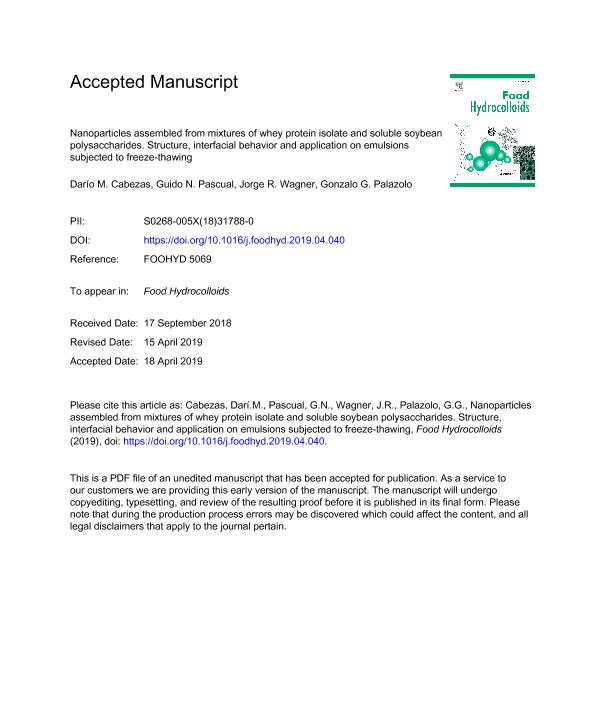Mostrar el registro sencillo del ítem
dc.contributor.author
Cabezas, Dario Marcelino

dc.contributor.author
Pascual, Guido N.
dc.contributor.author
Wagner, Jorge Ricardo

dc.contributor.author
Palazolo, Gonzalo Gastón

dc.date.available
2021-01-18T13:13:19Z
dc.date.issued
2019-10
dc.identifier.citation
Cabezas, Dario Marcelino; Pascual, Guido N.; Wagner, Jorge Ricardo; Palazolo, Gonzalo Gastón; Nanoparticles assembled from mixtures of whey protein isolate and soluble soybean polysaccharides. Structure, interfacial behavior and application on emulsions subjected to freeze-thawing; Elsevier; Food Hydrocolloids; 95; 10-2019; 445-453
dc.identifier.issn
0268-005X
dc.identifier.uri
http://hdl.handle.net/11336/122818
dc.description.abstract
In this article, the freeze-thaw stability of emulsions prepared with nanoparticles assembled from mixtures of whey protein isolate (WPI, 2.0% w/w)and soluble soybean polysaccharides (SSPS, 0.5% w/w)was assessed. The assembly was performed by pH adjustment to 3.0 without and with heating (90 °C, 15 min). Moreover, the order of addition of SSPS to proteins, before or after heating, was also studied. The complexes were characterized by dynamic light scattering, turbidity, non-sedimentable protein content, aromatic surface hydrophobicity (H 0 ), interfacial tension and interfacial rheology measurements at the oil/water interface. In all cases, the dispersions evidenced slightly-positive ζ-potential values due to electrostatic associative interactions between proteins and SSPS. Moreover, the complexation increased the particle size, the interfacial activity and the non-sedimentable protein content. Oil-in-water emulsions (30% w/w sunflower oil)prepared with unheated WPI/SSPS mixtures were more stable to freeze-thawing (−18 °C, 72 h; 20 °C, 2 h)respect to those prepared with WPI alone. When SSPS was added to previously heated proteins, the resultant emulsions also evidenced a high freeze-thaw stability. The large sedimentable species, which contributed to form a film of high viscoelasticity, could stabilize the emulsions by a Pickering mechanism. However, when SSPS and WPI were heated together, the resultant emulsions exhibited a low freeze-thaw stability due to a combination of poor emulsification ability and limited interfacial adsorption of large particles. The results of this article might have important implications in the preparation of highly acidic emulsion-based products resistant to freeze-thaw treatments.
dc.format
application/pdf
dc.language.iso
eng
dc.publisher
Elsevier

dc.rights
info:eu-repo/semantics/openAccess
dc.rights.uri
https://creativecommons.org/licenses/by-nc-nd/2.5/ar/
dc.subject
EMULSIONS
dc.subject
FREEZE-THAWING
dc.subject
NANOPARTICLES
dc.subject
SOLUBLE SOYBEAN POLYSACCHARIDES
dc.subject
STABILITY
dc.subject
WHEY PROTEIN ISOLATE
dc.subject.classification
Otras Nanotecnología

dc.subject.classification
Nanotecnología

dc.subject.classification
INGENIERÍAS Y TECNOLOGÍAS

dc.title
Nanoparticles assembled from mixtures of whey protein isolate and soluble soybean polysaccharides. Structure, interfacial behavior and application on emulsions subjected to freeze-thawing
dc.type
info:eu-repo/semantics/article
dc.type
info:ar-repo/semantics/artículo
dc.type
info:eu-repo/semantics/publishedVersion
dc.date.updated
2021-01-08T14:16:40Z
dc.journal.volume
95
dc.journal.pagination
445-453
dc.journal.pais
Países Bajos

dc.journal.ciudad
Amsterdam
dc.description.fil
Fil: Cabezas, Dario Marcelino. Universidad Nacional de Quilmes. Departamento de Ciencia y Tecnología. Área Ingeniería en Alimentos; Argentina. Consejo Nacional de Investigaciones Científicas y Técnicas; Argentina
dc.description.fil
Fil: Pascual, Guido N.. Universidad Nacional de Quilmes. Departamento de Ciencia y Tecnología. Área Ingeniería en Alimentos; Argentina
dc.description.fil
Fil: Wagner, Jorge Ricardo. Universidad Nacional de Quilmes. Departamento de Ciencia y Tecnología. Área Ingeniería en Alimentos; Argentina. Consejo Nacional de Investigaciones Científicas y Técnicas; Argentina
dc.description.fil
Fil: Palazolo, Gonzalo Gastón. Universidad Nacional de Quilmes. Departamento de Ciencia y Tecnología. Área Ingeniería en Alimentos; Argentina. Consejo Nacional de Investigaciones Científicas y Técnicas; Argentina
dc.journal.title
Food Hydrocolloids

dc.relation.alternativeid
info:eu-repo/semantics/altIdentifier/url/https://www.sciencedirect.com/science/article/pii/S0268005X18317880
dc.relation.alternativeid
info:eu-repo/semantics/altIdentifier/doi/https://doi.org/10.1016/j.foodhyd.2019.04.040
Archivos asociados
